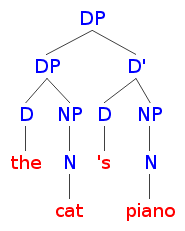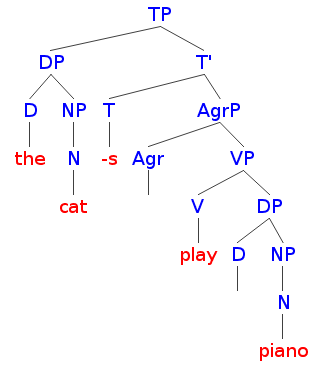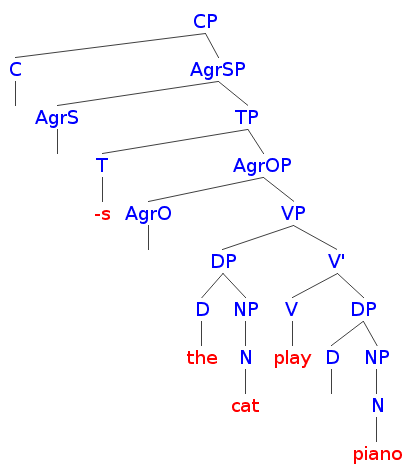How to Draw Syntax Trees, Part 5: Type 3 - A sentence is a TP
Previously on how to draw syntax trees: Part 4: Type 2 - A sentence is an IP.
Last time, X-bar theory gave us a very consistent framework around how we were drawing trees. This third framework is going to be less consistent because we’re getting closer to areas of active research, which means that there are more judgement calls to make about which parts you’re going to include in an intro linguistics or undergrad syntax course. But for the sake of keywords, these ideas are common when discussing Government and Binding Theory (GB) and Minimalism/the Minimalist Program, although they’re not necessarily crucial to either of them.
In most cases, an intro linguistics course won’t adopt everything from this section; however, I have seen some that adopt a piece or two, especially TPs or DPs. You would, however, probably encounter most of it (and generally other things) in an upper-year syntax course, again depending on the instructor and textbook. So I am not going to go into as much detail with explaining it all as I did in the previous sections: I’m just going to point out a few things.
The first thing is, remember how in the previous post I said we draw bar levels even when they aren’t strictly necessary? Well, we do if we’re still talking GB, but the reason Minimalism is called Minimalism is that it’s about getting rid of everything that isn’t strictly necessary. We always still draw at least the head and the phrase level, and we still draw as many bar levels as we need to keep everything binary branching, but at a certain point you’ll get told that you can stop drawing bar levels that just go straight down. I still think it’s a useful exercise to for people starting out to try drawing some trees with all the possible bar levels, because this was an important part of the theory for so long, but instructors will vary on when they tell you you don’t need to draw the extra all the N-bars and V-bars and so on. For the sake of compactness in the trees, I will now dispense with extra bar levels for the most part.
Revising NPs
The next thing we’re going to do is revise how we’re drawing NPs yet another time. But we’ll start with the version of NPs that we ended up with before.

This version worked fairly well as long as the only extra things we had with our nouns were adjective phrases, prepositional phrases, and determiners (like “the”, “my” and “this”). But what about possessive strings like “the cat’s piano”?
Intuitively, “the cat’s” should be kind of like a determiner, because you could swap it with “my”, “her”, “his”, etc. which are all determiners. But a determiner is a particular lexical category, just like noun or verb is, and you can’t say that a string of words is a determiner any more than you can say that a string of words is a noun or a verb. However, when we had a string of words that looked like a bigger version of “noun-y stuff” or “verb-y stuff”, we came up with noun phrases and verb phrases, so what about if we had a determiner phrase?
What would a determiner phrase look like? We know from drawing other phrases that it should have a head that’s a determiner (D), a bar level D’ (which we used to say was obligatory, but now we’re saying is only present when we really need it), and a maximal projection DP, as well as other things in its specifier and complement positions.
This gives us a way out of our “the cat’s” problem. We’ve said that the whole string “the cat’s” is kind of like a determiner in relation to “piano”, but it also clearly has another determiner (the) and a noun (cat) in it. So if we say that the ’s is the head of the main determiner phrase, and the “piano” is an NP which is its complement, we now have room in the specifier position for a second DP that contains the determiner “the” and the NP “cat”.

And we could make that second DP in spec contain a whole bunch of words, but no matter what, the ’s is still on the very outside edge of that whole thing (“the student of piano who I saw yesterday’s cat”). But the basic version of what we’ve been drawing until now as an NP with a Det as a specifier now looks like a DP with an NP as complement.

Plus, once we have D be the head of its own phrase, it makes sense why sometimes a D is found with an NP inside (“I like this piano but not that cat”) and sometimes without any NP at all (“I like this but not that”). And it’s not just demonstrative pronouns like “this” and “that”: any pronoun (“I”, “you”, “they”, etc) is a determiner in a DP with no NP complement.
In fact, once we introduce DPs, we now assume that all of the things we formerly called NPs are actually NPs inside DPs (even just plain “piano”). I’m not going to get into the reasons why, but here’s a decent explanation of those reasons, why pronouns are Ds, plus more about DPs vs NPs.
Revising IPs
The last big thing that we’re going to change is about inflection phrases (IPs). The English inflection system is pretty sparse, and the few inflections that we have combine several meanings (-s marks both third singular and present tense, and -ed marks past for any person) but other languages have lots more ways that you can inflect a verb. It’s especially common to make a distinction between inflecting for tense and inflecting for the person/number agreement of the subject (and sometimes the object). For example, the future tense in both French and Spanish has one part that means future and another distinct part that indicates who the subject is: parl-er-ai ‘speak-future-1sg’ and habl-ar-é 'speak-future-1sg’, both translated “I will speak”.
So later analyses often split up IP into the different types of things you can inflect for, specifically tense, T and TP, and person/number agreement, Agr and AgrP. You can even go as far as splitting up Agr into AgrS (subject agreement) and AgrO (object agreement), where AgrSP is above TP and AgrOP is below TP. It’s not common to use full-fledged TP, AgrSP, and AgrOP in intro courses, and many of the arguments for them involve a) other languages and b) movement, so I’m not going to get into them, but here’s more on AgrO and AgrS from an upper-year syntax course. And they’re worth the mention because I have seen intro courses that just use TP and not any type of AgrP. But if that happens, you don’t need to rush into the advanced stuff: you can just sub out all the IPs in the X-bar trees from the previous post with TPs (this is your prof getting you used to writing TP, not really asserting a difference between tense and agreement).
Anyway, let’s look at the same sentence as the previous sections “the cat plays piano”, drawn out in full using DP, TP and AgrP instead of NP and IP. First, here’s a version with at least one bar level in all phrases, if you’re not making the minimalist assumption that you can omit needless bar levels.

And secondly, here’s the more compact version with only the necessary bar levels (although note that we still have a DP and an AgrP with “invisible” heads).

Another theory that often comes in around this point is the VP-internal subject hypothesis (VPISH): basically the idea that subjects start out inside the VP and then both subjects and objects move up to their respective Agr. We’re not talking about movement here, so I don’t really want to get into VPISH, but here’s that tree if you’re interested, and here’s an explanation of movement from inside the VP. (I’m topping it with CP because by the time you’re drawing trees like this, you’re also often assuming that every sentence starts with CP.)

In the most detailed ways of drawing trees, you may also start to lose a boundary between morphology and syntax: every morpheme, regardless of whether it’s a unique word, is treated as a head and therefore gets a projection in the tree, as well as some heads that may not be visible/audible but for which we have some other type of evidence. This is not commonly intro material, but a few of them are NegP (negation), AspP (aspect), NumP (number), and splitting the VP into big VP and little vP.
This is part 5 of a series on how to draw syntax trees and how to make sense of the various online resources for doing so. Other posts in the series are below:
- So, you asked the internet how to draw syntax trees. Here’s why you’re confused.
- What do we even mean by a syntax tree?
- Type 1: A sentence is an S
- Type 2: A sentence is an IP
- Type 3: A sentence is a TP
- Reconciling theories and final notes
- Other resources and topics
- A step-by-step guide to drawing trees, with gifs
Don't miss out on any interesting linguistics! Get my monthly newsletter in your inbox.
Notes
 tremendoustrashjudgeempath-blog reblogged this from allthingslinguistic
tremendoustrashjudgeempath-blog reblogged this from allthingslinguistic  tremendoustrashjudgeempath-blog liked this
tremendoustrashjudgeempath-blog liked this  unfuckthereallife liked this
unfuckthereallife liked this hellochinups liked this
 seriedesiluetas liked this
seriedesiluetas liked this lizziwizzi082 liked this
 moragooyo liked this
moragooyo liked this  queeengj liked this
queeengj liked this  kayanoman reblogged this from allthingslinguistic
kayanoman reblogged this from allthingslinguistic  kayanoman liked this
kayanoman liked this faewrites liked this
bienenalster reblogged this from allthingslinguistic
 therumoursaretrue reblogged this from nooradeservedbetter
therumoursaretrue reblogged this from nooradeservedbetter nooradeservedbetter reblogged this from allthingslinguistic
lamat liked this
 iiriecadence liked this
iiriecadence liked this  distressed-angel reblogged this from allthingslinguistic
distressed-angel reblogged this from allthingslinguistic  distressed-angel liked this
distressed-angel liked this shona-moni liked this
tristrant liked this
 singerwood reblogged this from allthingslinguistic
singerwood reblogged this from allthingslinguistic non-arborescent liked this
lingua-file liked this
 jasminjuthdy liked this
jasminjuthdy liked this carliemarie liked this
bluedune liked this
gator-pie liked this
your-averagejo liked this
dreamatoria liked this
amilixkan-blog reblogged this from allthingslinguistic
amilixkan-blog liked this
anthrofreshtodeath liked this
mybifocalsareold reblogged this from allthingslinguistic
mybifocalsareold liked this
urh2o2fantasy liked this
 cupofbees liked this
cupofbees liked this blackboxmessiah reblogged this from allthingslinguistic
blackboxmessiah liked this
tellyouastory liked this
allthingslinguistic posted this
- Show more notes